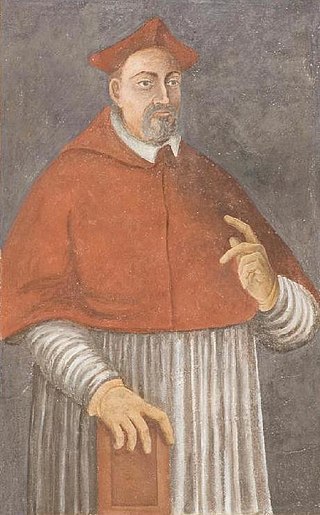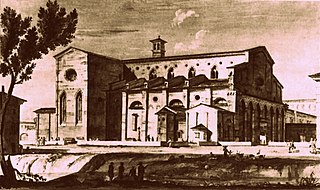
Padua is a city and comune in Veneto, northern Italy. Padua is on the river Bacchiglione, west of Venice. It is the capital of the province of Padua. It is also the economic and communications hub of the area. Padua's population is 214,000. The city is sometimes included, with Venice and Treviso, in the Padua-Treviso-Venice Metropolitan Area (PATREVE) which has a population of around 2,600,000.

Anthony of Padua, OFM or Anthony of Lisbon was a Portuguese Catholic priest and friar of the Franciscan Order. He was born and raised by a wealthy family in Lisbon, Portugal, and died in Padua, Italy. Noted by his contemporaries for his powerful preaching, expert knowledge of scripture, and undying love and devotion to the poor and the sick, he was one of the most quickly canonized saints in church history, being canonized less than a year after his death. He was proclaimed a Doctor of the Church by Pope Pius XII on 16 January 1946.
The Battle of the Oinousses Islands comprised two separate actions, on 9 and 19 February 1695 near the Oinousses, a small island group off Cape Karaburun in western Anatolia, between a Venetian fleet under Antonio Zeno and the Ottoman fleet under Mezzo Morto Hüseyin. The result of the first battle was a Venetian defeat, and although the second engagement ended in a draw, the Venetian position in Chios became untenable, forcing Zeno to abandon the island.

St. Sebastian is the subject of three paintings by the Italian Early Renaissance master Andrea Mantegna. The Paduan artist lived in a period of frequent plagues; Sebastian was considered protector against the plague as having been shot through by arrows, and it was thought that plague spread abroad through the air.

The Italian Catholic Diocese of Adria-Rovigo, in the Triveneto, has existed under this name since 1986. It is a Latin suffragan to the Patriarchate of Venice.

Megliadino San Fidenzio was a comune (municipality) in the Province of Padua in the Italian region of Veneto, located about 70 kilometres (43 mi) southwest of Venice and about 35 kilometres (22 mi) southwest of Padua.
Zuglio is a comune (municipality), former bishopric and Latin Catholic titular see in the Province of Udine in the northeastern Italian autonomous region Friuli-Venezia Giulia, located about 110 kilometres (68 mi) northwest of Trieste and about 45 kilometres (28 mi) northwest of Udine in the Val Bût.

The Roman Catholic Diocese of Padua is an episcopal see of the Catholic Church in Veneto, northern Italy. It was erected in the 3rd century. The diocese of Padua was originally a suffragan (subordinate) of the Patriarchate of Aquileia. When the Patriarchate was suppressed permanently in 1752, it became a suffragan of the Archdiocese of Udine. In 1818, when the dioceses of northern Italy were reorganized by Pope Pius VII, it became a suffragan of the Patriarchate of Venice, and remains so today.

San Francesco della Vigna is a Roman Catholic church in the Sestiere of Castello in Venice, northern Italy.

Francesco Pisani was an Italian Cardinal, born in Venice, the son of Alvise Pisani the noted banker, who was Procurator of S. Mark's, a member of the Council of Ten, and a Councilor of the Doge of Venice; and Cecilia Giustinian. He had a brother named Giovanni (Zuan), who also became Procurator of S. Marks' and was a Venetian diplomat; he was married to the sister of Doge Andrea Gritti. He was a strong supporter of the alliance between Venice, France and the Papacy, called the League of Cognac. He shared the imprisonment of Pope Clement VII in the Castel S. Angelo during the Sack of Rome and its aftermath. He spent eighteen months in exile in Naples while Clement made his peace with the Emperor Charles V.

The Basilica of Saint Anthony of Padua al Laterano is a Roman Catholic titular church in Rome on Via Merulana, one block from the Obelisk of St. John Lateran. It was built for the Order of Friars Minor, who needed a new home after they were moved from Santa Maria in Ara Coeli to allow the construction of the Victor Emmanuel II Monument.

Marie-Nicolas-Antoine Daveluy was a French missionary and saint. His feast day is March 30, and he is also venerated along with the rest of the 103 Korean martyrs on September 20.

Sant'Agostino is a former Gothic-style church in Padua, region of Veneto, Italy. It was razed to the ground in 1819 by the Austrian authorities to construct a military hospital.

The Sanctuary of Saint Anthony of Padua, also known as the Church of Saint Anthony of Padua is a Roman Catholic place of worship located in the city of Turin, Italy.

Antonio Diedo was an Italian architect. Born in Venice, he was active both in his natal city and the mainland towns of the Republic of Venice.

Antonio Mattiazzo is an Italian prelate of the Catholic Church who was Bishop of Padua with the personal title of archbishop from 1989 to 2015. He worked in the diplomatic service of the Holy See and was Apostolic Nuncio to Ivory Coast, Burkina Faso, and Niger from 1985 to 1989.

Fidentius of Padua was a Franciscan administrator and writer active in the Holy Land between 1266 and 1291. He wrote a tract on the Christian recovery and retention of the Holy Land.
Fidentian or Fidentius was the bishop of Hippo Regius from 303 until his martyrdom during the Great Persecution in 304. His predecessor, Leontius, was also martyred. He was the first of the Twenty Martyrs of Hippo to be executed after being imprisoned for refusing to make pagan sacrifices. A church at Hippo was later dedicated to the Twenty and at least one miracle was reported at it. Among Fidentian's companion martyrs were Valerian and Victoria. Augustine of Hippo later preached a sermon in their honour. Their feast day is 15 November in the Roman Martyrology, but they are not in the General Roman Calendar. The edition of the Martyrology of 1937 mangles their names.
This is an alphabetical index of people, places, things, and concepts related to or originating from the Republic of Venice. Feel free to add more, and create missing pages.















